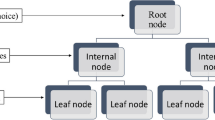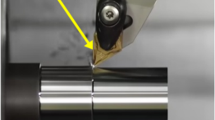Abstract
It is significant to ensure stable machining quality that accurately monitors the tool wear. Sensor signals are mainly used to predict tool wear. Therefore, complete sensor signals are crucial for tool wear prediction. To obtain comprehensive information on the process for improving prediction accuracy and ensuring the effectiveness of the prediction model when sensor data are missing, this paper proposes a tool wear prediction scheme through prioritization of sensor combinations under missing data. In this prediction scheme, the optimal feature subset of the sensor combination is obtained using kernel principal component analysis (KPCA) optimized by maximum information coefficient (MIC); that is, the MIC is employed to select the gamma value of the KPCA. Meanwhile, random forests are utilized to determine the prioritization of sensor combinations based on the obtained optimal feature subset. With the occurrence of signal loss, prediction errors exist. Thus, the sensor combination that replaces the sensor with missing data is selected according to the determined priority order. The effectiveness of the proposed scheme is verified through sensor combinations based on the cutting force, vibration, and acoustic emission during the milling process of TC18.









Similar content being viewed by others
Data availability
The datasets used or analyzed during the current study are available from the corresponding author on reasonable request.
Code availability
Not applicable.
References
Raja JE, Kiong LC, Soong LW (2013) Hilbert-Huang transform-based emitted sound signal analysis for tool flank wear monitoring. Arab J Sci Eng 388:2219–2226. https://doi.org/10.1007/s13369-013-0580-7
Drouillet C, Karandikar J, Nath C, Journeaux AC, El Mansori M, Kurfess T (2016) Tool life predictions in milling using spindle power with the neural network technique. J Manuf Process 22:161–168. https://doi.org/10.1016/j.jmapro.2016.03.010
Yang YF, Guo YL, Huang ZP, Chen N, Li L, Jiang YF, He N (2019) Research on the milling tool wear and life prediction by establishing an integrated predictive model. Measurement 145:178–189. https://doi.org/10.1016/j.measurement.2019.05.009
Maia LHA, Abram AM, Vasconcelos WL, Sales WF, Machado AR (2015) A new approach for detection of wear mechanisms and determination of tool life in turning using acoustic emission. Tribol Int 92:519–532. https://doi.org/10.1016/j.triboint.2015.07.024
Gierlak P, Burghardt A, Szybicki D, Szuster M, Muszynska M (2017) On-line manipulator tool condition monitoring based on vibration analysis. Mech Syst Signal Pr 89:14–26. https://doi.org/10.1016/j.ymssp.2016.08.002
Prickett PW, Johns C (1999) An overview of approaches to end milling tool monitoring. Int J Mach Tool Manu 391:105–122. https://doi.org/10.1016/S0890-6955(98)00020-0
Zhang L, Gao HL, Wen J, Li SC, Liu Q (2017) A deep learning-based recognition method for degradation monitoring of ball screw with multi-sensor data fusion. Microelectron Reliab 75:215–222. https://doi.org/10.1016/j.microrel.2017.03.038
Xu XW, Tao ZR, Ming WW, An QL, Chen M (2020) Intelligent monitoring and diagnostics using a novel integrated model based on deep learning and multi-sensor feature fusion. Measurement 165. https://doi.org/10.1016/j.measurement.2020.108086
Huang ZW, Zhu JM, Lei JT, Li XR, Tian FQ (2019) Tool wear predicting based on multisensory raw signals fusion by reshaped time series convolutional neural network in manufacturing. IEEE Access 7:178640–178651. https://doi.org/10.1109/ACCESS.2019.2958330
Qi JD, Chen B, Zhang DH (2020) Multi-information fusion-based belt condition monitoring in grinding process using the improved-Mahalanobis distance and convolutional neural networks. J Manuf Process 59:302–315. https://doi.org/10.1016/j.jmapro.2020.09.061
Shi CM, Luo B, He SP, Li K, Liu HQ, Li B (2019) Tool wear prediction via multi-dimensional stacked sparse autoencoders with feature fusion. IEEE T Ind Inform PP:1–1. https://doi.org/10.1109/TII.2019.2949355
Teti R, Segreto T, Caggiano A, Nele L (2020) Smart multi-sensor monitoring in drilling of CFRP/CFRP composite material stacks for aerospace assembly applications. Appl Sci 10:758. https://doi.org/10.3390/app10030758
Chen YX, ** Y, Jiri G (2018) Predicting tool wear with multi-sensor data using deep belief networks. Int J Adv Manuf Tech 99:1917–1926. https://doi.org/10.1007/s00170-018-2571-z
Liu CQ, Li YG, Zhou GY, Shen WM (2018) A sensor fusion and support vector machine based approach for recognition of complex machining conditions. J Intell Manuf 29:1739–1752. https://doi.org/10.1007/s10845-016-1209-y
Liu H, Liu ZY, Jia WQ, Zhang DH, Wang QD, Tan JR (2021) Tool wear estimation using a CNN-transformer model with semi-supervised learning. Meas Sci Technol. https://doi.org/10.1088/1361-6501/AC22EE
Su T, Shi Y, Yu JC, Yue CX, Zhou F (2021) Nonlinear compensation algorithm for multidimensional temporal data: a missing value imputation for the power grid applications. Knowl-Based Syst. https://doi.org/10.1016/j.knosys.2021.106743
Lin J, Li NH, Alam MA, Ma YQ (2020) Data-driven missing data imputation in cluster monitoring system based on deep neural network. Appl Intell 50:860–877. https://doi.org/10.1007/s10489-019-01560-y
Hamori S, Motegi K, Zhang Z (2020) Copula-based regression models with data missing at random. J Multivariate Anal 180:104654. https://doi.org/10.1016/j.jmva.2020.104654
Liu C, Wang GF, Li ZM (2015) Incremental learning for online tool condition monitoring using ellipsoid artmap network model. Appl Soft Comput 35:186–198. https://doi.org/10.1016/j.asoc.2015.06.023
Wang JJ, **e JY, Zhao R, Zhang LB, Duan LX (2016) Multisensory fusion based virtual tool wear sensing for ubiquitous manufacturing. Robot Cim-Int Manuf 45 https://doi.org/10.1016/j.rcim.2016.05.010
Liao XP, Zhou G, Zhang ZK, Lu J, Ma JY (2019) Tool wear state recognition based on GWO–SVM with feature selection of genetic algorithm. Int J Adv Manuf Tech 104:1051–1063. https://doi.org/10.1007/s00170-019-03906-9
Wu J, Su YH, Cheng YW, Shao XY, Deng C, Liu C (2018) Multi-sensor information fusion for remaining useful life prediction of machining tools by adaptive network based fuzzy inference system. Appl Soft Comput 68:13–23. https://doi.org/10.1016/j.asoc.2018.03.043
Shekar AK, Bocklisch T, Sánchez PI, Straehle CN, Müller E (2017) Including multi-feature interactions and redundancy for feature ranking in mixed datasets. Machine Learning and Knowledge Discovery in Databases. https://doi.org/10.1007/978-3-319-71249-9
Danasingh AA, Balamurugan S, Leavline EJ (2016) Literature review on feature selection methods for high-dimensional data. International Journal of Computer Applications. https://doi.org/10.5120/ijca2016908317
Reshef DN, Reshef YA, Finucane HK, Grossman SR, Turnbaugh MG, PJ, Lander ES, Mitzenmacher M, Sabeti PC, (2011) Detecting novel associations in large data sets. Science 334:1518–1524. https://doi.org/10.1126/science.1205438
Sick B (2002) On-line and indirect tool wear monitoring in turning with artificial neural networks: a review of more than a decade of research. Mech Syst Signal Pr 16:487–546. https://doi.org/10.1006/mssp.2001.1460
Suresh R, Joshi AG, Manjaiah M (2021) Experimental investigation on tool wear in AISI H13 die steel turning using RSM and ANN methods. Arab J Sci Eng 46:2311–2325. https://doi.org/10.1007/s13369-020-05038-9
Zhang KF, Yuan HQ, Nie P (2015) A method for tool condition monitoring based on sensor fusion. J Intell Manuf 26:1011–1026. https://doi.org/10.1007/s10845-015-1112-y
Kong DD, Chen YJ, Li N (2018) Gaussian process regression for tool wear prediction. MechSyst Signal Pr 104:556–574. https://doi.org/10.1016/j.ymssp.2017.11.021
Yuan J, Liu LB, Yang ZQ, Zhang YR (2020) Tool wear condition monitoring by combining variational mode decomposition and ensemble learning. Sensors. https://doi.org/10.3390/s20216113
Bustillo A, Reis R, Machado AR, Pimenov DY (2020) Improving the accuracy of machine-learning models with data from machine test repetitions. J Intell Manuf. https://doi.org/10.1007/s10845-020-01661-3
Wu DZ, Jennings C, Terpenny J, Gao RX, Kumara S (2017) A comparative study on machine learning algorithms for smart manufacturing: tool wear prediction using random forests. J Manuf Sci E-T Asme doi 10(1115/1):4036350
Bustillo A, Pimenov DY, Matuszewski M, Mikolajczyk T (2018) Using artificial intelligence models for the prediction of surface wear based on surface isotropy levels. Robot Cim-Int Manuf 53:215–227. https://doi.org/10.1016/j.rcim.2018.03.011
Oo H, Wang W, Liu ZH (2020) Tool wear monitoring system in belt grinding based on image-processing techniques. Int J Adv Manuf Technol 111:2215–2229. https://doi.org/10.1007/s00170-020-06254-1
Ho TK (1995). Random decision forests. https://doi.org/10.1007/978-0-387-30164-8_694
Funding
This research is supported by the National Natural Science Foundation of China (NSFC) (Grant No. 51665005 and Grant No. 52165062), the Guangxi Natural Science Foundation Program (Grant No. 2020JJD160004 and 2019JJB160048), and the project of improving the basic scientific research ability of young and middle-aged teachers of colleges and universities in Guangxi (Grant No. 2020KY10014).
Author information
Authors and Affiliations
Contributions
Zhenjun Wu contributed to the process and summary of the study and wrote the manuscript. Zhenjun Wu, Juan Lu, Yujia Li, Yonghui Chen, and Jian Feng designed and carried out the experiment. Junyan Ma and ** Liao guided the concept, direction, and experiments of research. Zhenjun Wu tested the results and analyzed the data.
Corresponding author
Ethics declarations
Ethics approval and consent to participate
All authors agreed with the consent to participate.
Consent to publish
All authors have read and agreed to the published version of the manuscript.
Competing interests
The authors declare no competing interests.
Additional information
Publisher's Note
Springer Nature remains neutral with regard to jurisdictional claims in published maps and institutional affiliations.
Rights and permissions
About this article
Cite this article
Wu, Z., Lu, J., Li, Y. et al. Tool wear prediction under missing data through prioritization of sensor combinations. Int J Adv Manuf Technol 120, 2715–2729 (2022). https://doi.org/10.1007/s00170-022-08916-8
Received:
Accepted:
Published:
Issue Date:
DOI: https://doi.org/10.1007/s00170-022-08916-8




